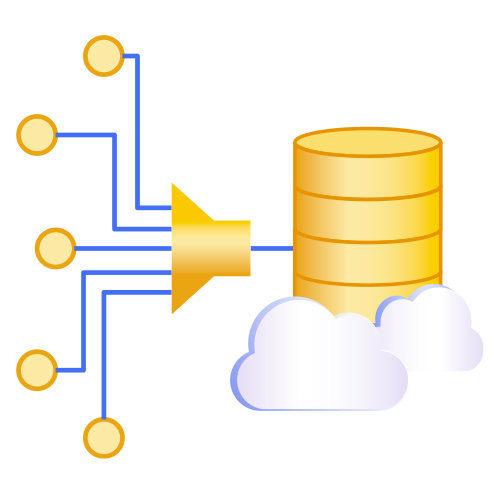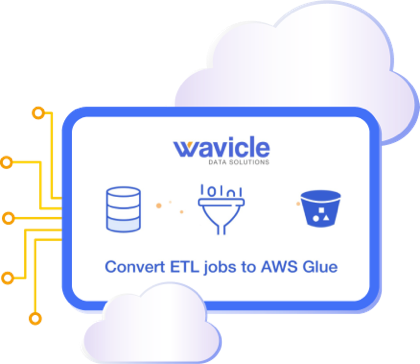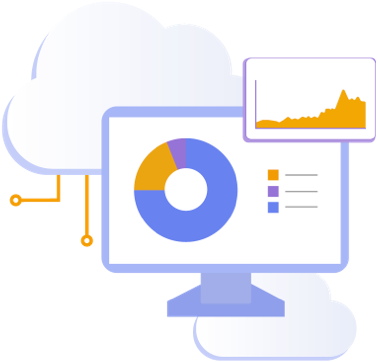
The cloud evolution is no longer a movement for modern business, it’s an inescapable reality. A vastly greater amount of data sources, the volume of customer data, and disruptions to the supply chain call for companies to fully utilize the cloud and its unlimited compute and capacity.
To keep up, organizations need real-time data processing for scalability and to empower decision-makers with data faster. But for many, a barrier for cloud migration, cloud utilization and data integration remains — in the form of traditional extract, transform, and load (ETL) platforms.
At Wavicle, we create ETL migration and modernization strategies at a holistic level based on business processes and goals, use cases, and current technology stacks.
For AWS users, AWS Glue is a serverless and scalable data integration option.
Traditional ETL processes consist of the development of batched data pipelines for on-premise sources tied to conventional hardware infrastructure. While still necessary today, the technology isn’t for high-speed processing. Legacy ETL platforms are mostly designed for relational databases and other traditional data sources.
For today’s exponentially increased pace, volume, and multi-source data, legacy ETL platforms do not have the agility to transform data at the speed for loading into a data warehouse or data lake.
Beyond the inability to keep up with the momentum of modern big data, legacy ETL platforms come with other inherent shortcomings.
Legacy ETL platforms are slow from a user perspective. When a company has thousands or tens of thousands of ETL jobs for moving data or applications to the cloud, timelines become a serious pain point.
For platforms like Informatica, Datastage, or other legacy ETL solutions, licensing costs present a major financial burden for growing organizations. These tools contain their engines for data transformation, requiring investment into servers and storage. With modern ETL platforms like AWS Glue, the vendor absorbs the infrastructure cost.
Legacy ETL platforms are not designed as open-source and subsequently, have serious limitations for integrating with other open-source technology like Databricks. According to an IBM survey, open-source software was rated equal to or better than proprietary software by 94% of respondents.
Legacy ETL platforms were not designed for the cloud. This means they aren’t capable of unlimited scalability, an inherent value pillar for the cloud. The lack of cloud design also means many tools won’t support cloud-base.
Maintenance, upgrades, and renewals of legacy ETL platforms require dedicated managers. These time-consuming processes and operations drain internal team resources and bandwidth. With AWS Glue and other modern ETL tools, most services are managed.
Traditional ETL tools often have a limited number of allowed processes for users.
Organizations across various industries have already moved to ETL modernization. At Wavicle, we see various mistakes from strategy to implementation.
“The cloud does it all for us right?” Eh, not so much. It still takes a tremendous amount of manual work to set up processes in the cloud for modern ETL platforms. Organizations often overlook the cost and bandwidth associated with building these processes.
Beyond setup, we often see a lack of internal expertise and experience in how scalability works when it comes to modern ETL platforms and an organization’s preferred cloud.
If not accounted for during an initial strategy phase, organizations can overlook capabilities that were widely used by their internal teams within their prior platform. This can stall the rapid utilization that is expected with a modern ETL platform.
Some modern ETL tools do not support connectivity to on-premise systems at all. If this isn’t accounted for and addressed, organizations can face a major ingestion challenge with their remaining on-premises systems.
At Wavicle, we design and deliver fast, quality data and analytics solutions that drive business results. We understand the importance of your investment in the cloud. To maximize your return on investment, ETL migrations and modernizations are necessary roadblocks to overcome.
But the roadblock is costly, consists of a tremendous amount of manual effort, and requires a long-term and strategic approach to get right. As consultants, we follow a proven ETL migration and modernization strategy.
We help you identify your business goals, assess your current ETL platforms, discover how the ETL tools fit with your current tech stack, and deliver an estimated total cost of ownership (TCO).
We determine your ETL migration and modernization strategy, align it to business goals, determine the complexity of the jobs, and set timelines for completion.
Now you’re ready for the ETL modernization. But as stated above, how long will it take to transform and migrate thousands or even tens of thousands of ETL jobs? Wavicle accelerators automate ETL migrations for reduced operational costs, shorter timelines, and fewer mistakes.

Automate the development of ingestion pipelines without custom coding.

Modernize your ETL infrastructure by migrating to AWS Glue in 80-90% less time.

Ensure database table structures are accurately converted from one database to another while reducing downtime and database migration timelines by up to 25%.
Even with automation, strong data management processes need to be put in place for success.
A prime example of a modern ETL is AWS Glue, a serverless data integration service that makes it easy to discover, prepare, and combine data for analytics, machine learning, and application development. Its value pillars are faster data integration, automating data integration at scale, and running on a serverless environment.
It provides both visual and code-based interfaces and users can find and access data rapidly using the AWS Glue Data Catalog. Data engineers and ETL developers alike can visually create, run, and monitor ETL workflows with the AWS Glue Studio.
For data analysts and data scientists, AWS GlueDatabrew enriches, cleans, and normalizes data without writing code. With AWS Glue Elastic Views, application developers can use familiar SQL to combine and replicate data across different data stores.
As AWS Advanced Consulting Partners, Wavicle is recognized for our expertise and extensive client work.
So, is ETL going to turn into a relic of the past? Not quite. As cloud-based services continue to dominate the landscape, traditional tools will have a hard time keeping up. But the concept of Extract, Transform, and Load will continue for the foreseeable future.
With the rise of cloud data platforms like Snowflake, Extract, Load, Transform (ELT) stores data in its raw form into a data lake.
For an overall migration to AWS, Azure, or GCP, traditional ETL platforms have become a roadblock in fully utilizing the cloud, cloud-based services, and modern data analytics.
Migrating from a legacy ETL platform to a modern ETL platform, enables the need for real-time data processing, scalability, and the ability to efficiently handle large volumes of data required by data pipelines for machine learning, data science workloads, DataOps, MLops, and more.
Migrating ETL platforms is a time-consuming and expensive process for organizations. At Wavicle, our experience, proven strategy, and accelerators drastically reduce migration timelines and provide cost savings.
View our on-demand webinar, “Modernizing ETL for Faster Cloud Data Migration,” with insights from TDWI, Wavicle, and AWS. Learn how modern ETL services and tools can help you leverage the cloud and its unlimited compute and capacity.